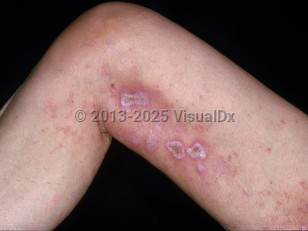Drug-induced skin ulcers
Alerts and Notices
Important News & Links
Synopsis

Hydroxyurea
Hydroxyurea is used in the treatment of myeloproliferative disorders and to prevent painful attacks in sickle-cell disease. Painful leg ulcers occur in approximately 9% of patients taking long-term high-dose hydroxyurea (greater than 1 g/day for at least 1 year) for myeloproliferative diseases. The etiology of the leg ulcers is thought to be related to reduced skin cell viability due to inhibition of DNA synthesis. Some reports have described these ulcerations occurring when hydroxyurea therapy is stopped.
All-trans-Retinoic Acid
All-trans-retinoic acid (ATRA) is a generally well-tolerated induction chemotherapeutic agent used for acute promyelocytic leukemia. In rare cases, patients may develop multiple small, painless ulcers limited to the scrotum. The etiology of the scrotal ulcers is poorly understood, but they may be due to ATRA-induced release of cytokines and interleukins resulting in leukocyte activation and tissue damage.
Systemic Retinoids
Systemic retinoids, such as isotretinoin, are used in the treatment of a variety of skin conditions, including acne. There are rare reports of patients on isotretinoin subsequently developing ulcerative lesions consistent with pyoderma gangrenosum. The etiology is unknown but may be related to increased skin fragility, vascular proliferation, or alteration of neutrophil adhesion requirements.
Methotrexate
Methotrexate is used for a variety of conditions, including psoriasis. Rarely, patients taking methotrexate for psoriasis have developed burning ulcerations at the sites of former psoriatic lesions, most commonly within days to weeks after starting therapy. Increases in the dose of methotrexate and concurrent use of NSAIDs are risk factors. Although the underlying mechanism is unknown, these ulcers are thought to be due to reduced keratinocyte viability as a result of DNA synthesis inhibition. Methotrexate can also induce oral ulcerations, which may be a sign of leukopenia.
Interferon-Beta
Interferon-β is a therapy used in the treatment of multiple sclerosis. There are rare reports of patients developing ulcers at inoculation sites. The ulcer etiology is poorly understood but may be related to cytokine-mediated inflammatory reactions in the dermis due to interferon-β.
Antiviral Medications
There are rare case reports in the literature of patients developing genital ulcerations while receiving foscarnet or lamivudine antiviral therapies. This is most commonly reported in human immunodeficiency virus (HIV)-infected patients receiving foscarnet for resistant herpetic infections. The etiology of these ulcerations is not understood, but some have proposed that the excreted drug in the urine causes an irritant contact dermatitis after being trapped under the foreskin of the penis in uncircumcised male patients.
Kinase Inhibitors
Kinase inhibitors are used in the treatment of certain cancers. There are rare case reports in the literature of patients developing painful leg ulcers (sunitinib) and painful oral ulcers (imatinib). The etiologies of these reactions are unknown; however, in the case of sunitinib, it is thought that ischemia due to inhibition of vascular endothelial growth factor (VEGF) may play a role, with pre-existing diabetes being a risk factor.
Nicorandil
Nicorandil is an anti-anginal medication that is not currently available in the United States but commonly used in Europe. In rare cases, it may be associated with painful ulcerations developing within several weeks to months after starting treatment. Oral ulcers are most common, but perianal ulcers and cutaneous ulcers are also seen. The etiology of the ulcers is unknown, but some have suggested that susceptibility to ulceration may be due to nicotinic acid accumulation or poor perfusion as a result of dilation of capacitance vessels.
Nicolau Syndrome
While not a cutaneous ulceration due to a particular medication, this syndrome describes a cutaneous phenotype associated with multiple different medications. Nicolau syndrome describes cutaneous ulceration due to intradermal or intravascular injection of a medication that leads to subsequent tissue necrosis. This has been described with a variety of drugs but may occur particularly with medications that exist in a crystallized form which are then not dissolved completely prior to injection. Some medications are stored refrigerated and intended to be brought to room temperature prior to injection; if the medications are injected while cold and crystals remain, it can lead to intravascular injury and tissue damage, and secondary cutaneous ulceration due to physical factors unrelated to the particular medication.
Illicit Drug Abuse
While beyond the scope of this section, it is possible for patients to develop cutaneous ulcerations at sites of intradermal injections of recreational drugs. "Skin popping," eg, self-injection of pentazocine, is an important example. Cocaine can also cause cutaneous ulcerations due to vasculitis and/or vasculopathy, particularly if the cocaine is diluted or adulterated with levamisole (see cocaine levamisole toxicity).
Codes
L98.491 – Non-pressure chronic ulcer of skin of other sites limited to breakdown of skin
T50.905A – Adverse effect of unspecified drugs, medicaments and biological substances, initial encounter
SNOMEDCT:
110285005 – Drug-induced ulceration
403642000 – Cutaneous ulceration due to cytotoxic therapy
403643005 – Methotrexate skin ulceration
Look For
Subscription Required
Diagnostic Pearls
Subscription Required
Differential Diagnosis & Pitfalls

Subscription Required
Best Tests
Subscription Required
Management Pearls
Subscription Required
Therapy
Subscription Required
Drug Reaction Data
Subscription Required
References
Subscription Required

